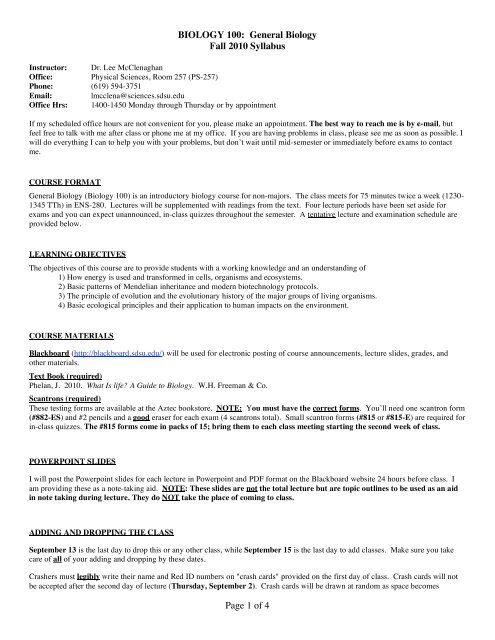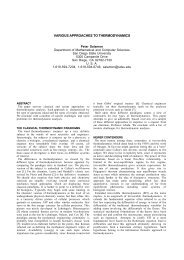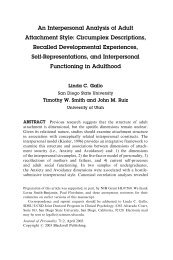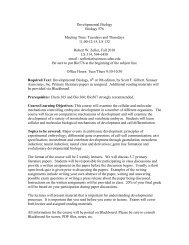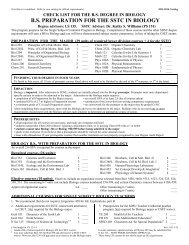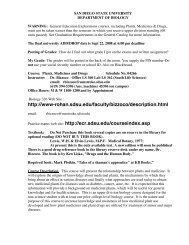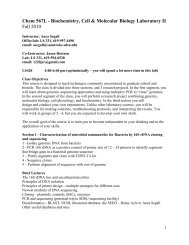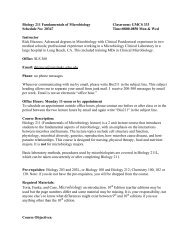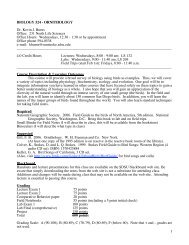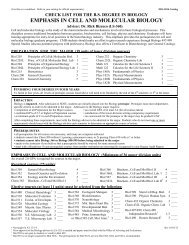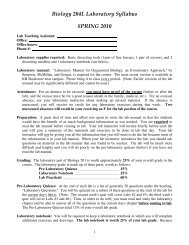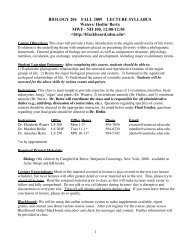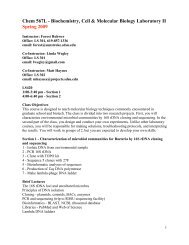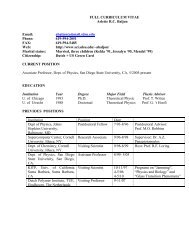Biol 100: General Biology
Biol 100: General Biology
Biol 100: General Biology
Create successful ePaper yourself
Turn your PDF publications into a flip-book with our unique Google optimized e-Paper software.
BIOLOGY <strong>100</strong>: <strong>General</strong> <strong>Biol</strong>ogy<br />
Fall 2010 Syllabus<br />
Instructor: Dr. Lee McClenaghan<br />
Office: Physical Sciences, Room 257 (PS-257)<br />
Phone: (619) 594-3751<br />
Email: lmcclena@sciences.sdsu.edu<br />
Office Hrs: 1400-1450 Monday through Thursday or by appointment<br />
If my scheduled office hours are not convenient for you, please make an appointment. The best way to reach me is by e-mail, but<br />
feel free to talk with me after class or phone me at my office. If you are having problems in class, please see me as soon as possible. I<br />
will do everything I can to help you with your problems, but don’t wait until mid-semester or immediately before exams to contact<br />
me.<br />
COURSE FORMAT<br />
<strong>General</strong> <strong>Biol</strong>ogy (<strong>Biol</strong>ogy <strong>100</strong>) is an introductory biology course for non-majors. The class meets for 75 minutes twice a week (1230-<br />
1345 TTh) in ENS-280. Lectures will be supplemented with readings from the text. Four lecture periods have been set aside for<br />
exams and you can expect unannounced, in-class quizzes throughout the semester. A tentative lecture and examination schedule are<br />
provided below.<br />
LEARNING OBJECTIVES<br />
The objectives of this course are to provide students with a working knowledge and an understanding of<br />
1) How energy is used and transformed in cells, organisms and ecosystems.<br />
2) Basic patterns of Mendelian inheritance and modern biotechnology protocols.<br />
3) The principle of evolution and the evolutionary history of the major groups of living organisms.<br />
4) Basic ecological principles and their application to human impacts on the environment.<br />
COURSE MATERIALS<br />
Blackboard (http://blackboard.sdsu.edu/) will be used for electronic posting of course announcements, lecture slides, grades, and<br />
other materials.<br />
Text Book (required)<br />
Phelan, J. 2010. What Is life? A Guide to <strong>Biol</strong>ogy. W.H. Freeman & Co.<br />
Scantrons (required)<br />
These testing forms are available at the Aztec bookstore. NOTE: You must have the correct forms. You’ll need one scantron form<br />
(#882-ES) and #2 pencils and a good eraser for each exam (4 scantrons total). Small scantron forms (#815 or #815-E) are required for<br />
in-class quizzes. The #815 forms come in packs of 15; bring them to each class meeting starting the second week of class.<br />
POWERPOINT SLIDES<br />
I will post the Powerpoint slides for each lecture in Powerpoint and PDF format on the Blackboard website 24 hours before class. I<br />
am providing these as a note-taking aid. NOTE: These slides are not the total lecture but are topic outlines to be used as an aid<br />
in note taking during lecture. They do NOT take the place of coming to class.<br />
ADDING AND DROPPING THE CLASS<br />
September 13 is the last day to drop this or any other class, while September 15 is the last day to add classes. Make sure you take<br />
care of all of your adding and dropping by these dates.<br />
Crashers must legibly write their name and Red ID numbers on "crash cards" provided on the first day of class. Crash cards will not<br />
be accepted after the second day of lecture (Thursday, September 2). Crash cards will be drawn at random as space becomes<br />
Page 1 of 4
available through drops during the add/drop period. Students whose names have been drawn will be announced at the beginning of<br />
each class period and they can obtain their Regline add code after class. The last day for adding crashers will be Tuesday, September<br />
14. Note: You must be present on the day your name is called or your add code will be given to another student.<br />
EXAMINATIONS, QUIZZES, AND GRADING<br />
Your grade will be determined by your performance on examinations and in-class quizzes. Exams will be multiple-choice and will<br />
consist of questions taken from my lecture notes. You will not be tested on material from the book unless it has been discussed in<br />
lecture. Four lecture exams have been scheduled. These four exams are of equal weight (<strong>100</strong> points each). Each exam will be graded<br />
on a curve based on overall class performance. Exam keys will be put on the class Blackboard site immediately after each exam. The<br />
scantron grading machine sometimes makes errors. If you believe there were errors made in the grading of your exam, you may<br />
request that it be re-graded by hand. You have ONE WEEK after the scores for the exam have been posted on Blackboard to<br />
request a re-grade of your scantron.<br />
Here is the examination schedule for the semester:<br />
Exam 1: September 23<br />
Exam 2: October 19<br />
Exam 3: November 18<br />
Exam 4: December 16 (Note: This exam begins at 1300)<br />
If illness or other serious problems beyond your control prevent you from taking an exam, you are expected to provide some kind of<br />
verification of the reason, such as a note from Student Health Services. Make-up exams (upon verified excused absence) will<br />
consist of essay and short-answer questions. You must contact me no later than one day after the regular exam with a valid<br />
excuse to be accorded the privilege of taking a make-up exam.<br />
In addition to exams, in-class quizzes will also be given and will make up about 15% of your grade. There will be 8 unannounced<br />
quizzes and each quiz will be worth 10 points. Your lowest quiz score will be dropped. There are no makeup quizzes regardless<br />
of your reason for missing the quiz.<br />
Your semester grade will be based upon the total number of points that you accumulate on exams and your best 7 quizzes. A total of<br />
470 points are possible for the semester. Plus/minus grades be assigned at the end of the semester.<br />
I may give the entire class an opportunity to earn “extra credit” from time to time. However, there’s no such thing as “extra credit”<br />
on an individual basis.<br />
CHEATING<br />
It is hoped that cheating will not be a problem in this course. Nevertheless, to avoid any possibility of you not recognizing what the<br />
consequences are, this is my policy: If you are caught cheating on an exam or quiz, you will receive a zero on the exam or quiz.<br />
In addition, the event may be reported to campus judicial authorities, which may lead to additional actions by the University.<br />
NOTE: Turning in work for other students in their absence from class IS CHEATING and will be dealt with as such.<br />
HOW TO SUCCEED IN BIOLOGY <strong>100</strong><br />
1. Make coming to class a habit. Scientific studies show that students who come to class get better grades than those who do not.<br />
NOTE: Simply obtaining the lecture slides from the class’s Blackboard site is NOT a substitute for coming to class!<br />
2. Make use of my office hours to get help if you need it. If you are not free during my office hours, make an appointment with me<br />
for some time that is convenient for both of us.<br />
3. Be on time to class. Class runs from 1230 to 1345. Be ready to begin promptly at 1230 and don't plan on leaving before 1345.<br />
4. Be attentive in class. Please sit quietly, pay attention and take notes. Turn off your cell phones and remove your iPod earbuds.<br />
Distractions and disruptions during lecture will not be tolerated; I will ask you to leave if, in my judgment, you are being<br />
disruptive.<br />
5. Ask questions. If something in lecture isn’t clear, don’t be afraid to ask questions. Undoubtedly, someone else has the same<br />
question.<br />
Page 2 of 4
6. Be organized. Us a binder or folder to keep your notes, handouts, scantrons and any other course materials together all in one<br />
place. Bring your binder to class.<br />
7. Be prepared. Read the assigned readings from the text and download the lecture slides BEFORE class.<br />
Page 3 of 4
BIOLOGY <strong>100</strong> CALENDAR – Fall 2010<br />
Week # Date Topic Text Readings*<br />
1 August 31 Lecture 1: Introduction to Bio <strong>100</strong>; Scientific Thinking Chpt. 1<br />
September 2 Lecture 2: Chemistry -- Part 1 Chpt. 2: 36-49<br />
2 7 Lecture 3: Chemistry – Part 2 Chpt. 2: 50-71<br />
9 Lecture 4: Cells – Part 1 Chpt. 3: 76 - <strong>100</strong><br />
3 14 Lecture 5: Cells – Part 2 Chpt. 3: 103 - 121<br />
16 Lecture 6: Energy -- Photosynthesis Chpt. 4: 122 - 142<br />
4 21 Lecture 7: Energy – Cellular Respiration Chpt. 4: 143 - 157<br />
23 EXAM 1<br />
5 28 Lecture 8: DNA Chpt. 5: 158 - 178<br />
30 Lecture 9: Biotechnology Chpt. 5: 179 - 207<br />
6 October 5 Lecture 10: Chromosomes and Cell Division – Part 1 Chpt. 6: 208 - 234<br />
7 Lecture 11: Chromosomes and Cell Division – Part 2 Chpt. 6: 235 - 247<br />
7 12 Lecture 12: Mendelian Inheritance – Part 1 Chpt. 7: 248 - 264<br />
14 Lecture 13: Mendelian Inheritance – Part 2 Chpt. 7: 265 - 281<br />
8 19 EXAM 2<br />
21 Lecture 14: Evolution and Natural Selection – Part 1 Chpt. 8: 282 - 303<br />
9 26 Lecture 15: Evolution and Natural Selection – Part 2 Chpt. 8: 304 - 327<br />
28 Lecture 16: The Origin and Diversification of Life on Earth Chpt. 10: 374 - 398<br />
10 November 2 Lecture 17: Animal Diversification – Part 1 Chpt. 11: 406 - 426<br />
4 Lecture 18: Animal Diversification – Part 2 Chpt. 11: 427 - 445<br />
11 9 Lecture 19: Plant and Fungi Diversification Chpt. 12<br />
11 VETERAN’S DAY – NO CLASS<br />
12 16 Lecture 20: Evolution and Diversity Among the Microbes Chpt. 13: 482 - 503<br />
18 EXAM 3<br />
13 23 Lecture 21: Population Ecology – Part 1 Chpt. 14: 514 - 531<br />
25 THANKSGIVING VACATION – NO CLASS<br />
14 30 Lecture 22: Population Ecology – Part 2 Chpt. 14: 538 - 547<br />
December 2 Lecture 23: Ecosystems and Communities – Part 1 Chpt. 15: 548 - 568<br />
15 7 Lecture 24: Ecosystems and Communities – Part 2 Chpt. 15: 569 - 585<br />
9 Lecture 25: Conservation and Diversity Chpt. 16: 586 - 613<br />
16 EXAM 4 (1300 - 1500)<br />
*Phelan, J. 2010. What Is life? A Guide to <strong>Biol</strong>ogy. W.H. Freeman & Co.<br />
Page 4 of 4


